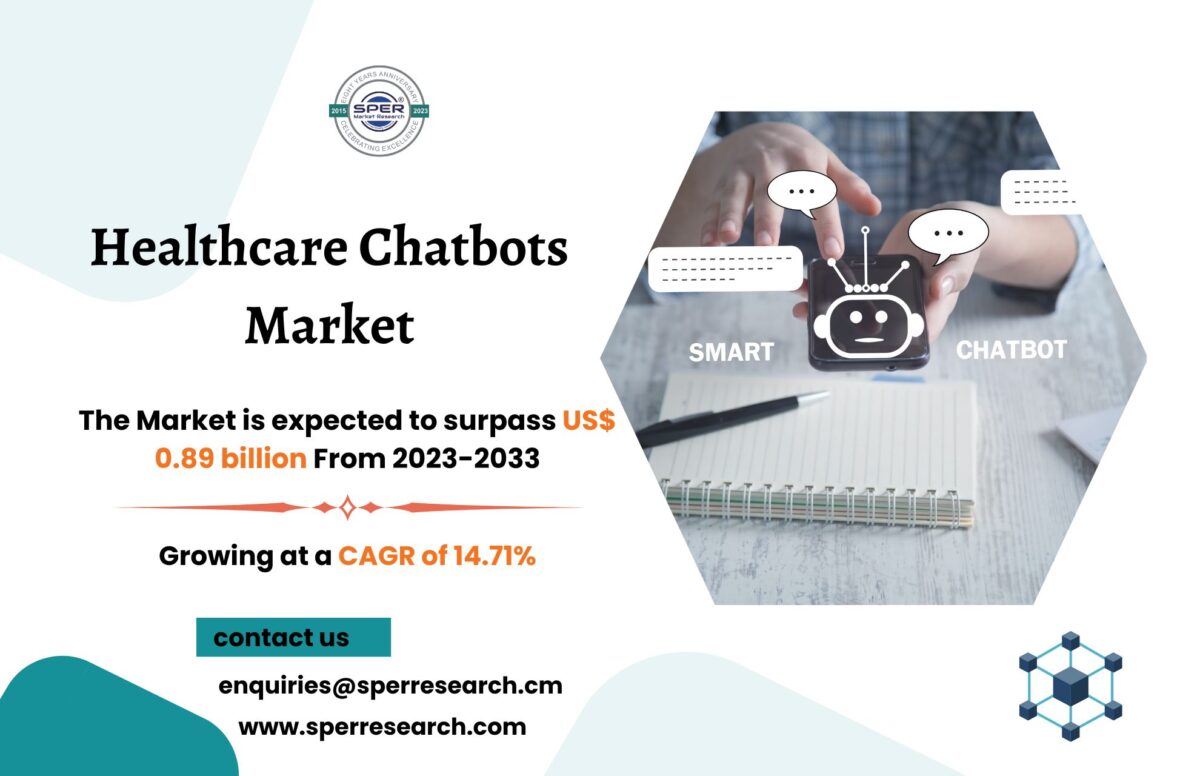Healthcare Chatbots Market Growth, Share, Revenue, Upcoming Trends, CAGR Status, Business Challenges and Future Investment till 2033: SPER Market Research

Healthcare chatbots is an area of the healthcare industry that focuses on creating, integrating, and deploying chatbot technology in healthcare settings. A healthcare chatbot is an artificial intelligence (AI) computer that uses natural language processing (NLP) to engage with users, most of whom are patients or healthcare professionals. Chatbots is a software that allow humans and artificial intelligence to communicate with each other. Chatbots communicate with customers via text or audio. The conversation is carried out with pre-calculated phrases in the form of text. Patients use these chatbots, which are either cloud-based or on-premise, to check their symptoms, find clinics, and arrange appointments. Furthermore, healthcare payers employ healthcare chatbots to create relationships with potential clients.
According to SPER Market Research, Healthcare Chatbots Market Size- By Component, Deployment Model, By Application, By End User- Regional Outlook, Competitive Strategies and Segment Forecast to 2033’ states that the Global Healthcare Chatbots Market is estimated to reach USD 0.89 billion by 2033 with a CAGR of 14.71%.
The growth of the healthcare chatbots market is due to increase in hospital cost reductions as a result of the adoption of healthcare chatbots internationally. Another factor driving market growth is the increase in internet connectivity and the use of smart gadgets. Furthermore, the market for healthcare chatbots is developing as patient wait times rise and there is a global lack of effective patient management. Healthcare chatbots give 24/7 availability and accessibility to healthcare information and services. Chatbots allow patients to seek assistance, ask questions, and receive individualized instruction at any time, removing the need to wait for regular office hours or stand in large lines. Healthcare chatbots can help to cut healthcare expenses by automating common operations like appointment booking, billing inquiries, and basic symptom evaluation. Chatbots save healthcare workers time by performing these activities.
Healthcare chatbots deal with sensitive patient information such as medical history, symptoms, and personal details. Ensuring strong privacy and data security safeguards is critical for protecting patient confidentiality and adhering to healthcare legislation. Any breaches or mismanagement of patient data can undermine trust in chatbot technology and impede market growth. Chatbots are intended to provide medical information and advice, however there is a possibility of errors or misinterpretations. The dependability and accuracy of chatbot responses are determined by the quality of the underlying algorithms and training data. To prevent giving inaccurate or perhaps hazardous advice, chatbots must have access to thorough and current medical knowledge.
Request For Free Sample Report @ https://www.sperresearch.com/report-store/healthcare-chatbots-market.aspx?sample=1
Impact of COVID-19 on Healthcare Chatbots Market
The use of chatbots in healthcare has grown since the pandemic. According to the World Economic Forum, Microsoft’s chatbot development tool has been used to create over a thousand COVID-19-specific chatbots. The premiere of the SUTRA smart chatbot, which supports COVID-19 patients in identifying nearby verified plasma donors and healthcare institutions, was announced in May 2021 by Sapio Analytics and the Government of India. A chatbot is created for those who live in tiny communities or do not have access to digital platforms and networks. The epidemic has hastened the development of healthcare chatbots, which provide 24/7 access to COVID-19 information while also supporting mental health during the crisis.
Healthcare Chatbots Market Key Players:
North America dominates the worldwide healthcare chatbots market due to its large number of healthcare facilities, the strong presence of significant market participants, the growing need for virtual health aid. Some of the key companies are Buoy Health, Inc, GYANT.Com, Infermedica Sp. z o.o, Inc, Microsoft, Sense.ly Inc, PACT Care B.V.
Healthcare Chatbots Market Segmentation:
The SPER Market Research report seeks to give market dynamics, demand, and supply forecast for the years up to 2033. This report contains statistics on product type segment growth estimates and forecasts
By Component: Based on the Component, Global Healthcare Chatbots Market is segmented as; Software, Service.
By Deployment Model: Based on the Deployment Model, Global Healthcare Chatbots Market is segmented as; Cloud, On-Premise, Others.
By Application: Based on the Application, Global Healthcare Chatbots Market is segmented as; Symptom Check, Medical Assistance, Appointment Booking, Others.
By End User: Based on the End User, Global Healthcare Chatbots Market is segmented as; Patient, Healthcare Providers, Insurance Companies, Others.
By Region: This report also provides the data for key regional segments of North America, Asia-Pacific, Latin America, Middle East & Africa and Europe.
This study also encompasses various drivers and restraining factors of this market for the forecast period. Various growth opportunities are also discussed in the report.
For More Information, refer to below link:-
Healthcare Chatbots Market Share
Related Reports:
Follow Us –
LinkedIn | Instagram | Facebook | Twitter
Contact Us:
Sara Lopes, Business Consultant — U.S.A.
SPER Market Research
+1–347–460–2899









